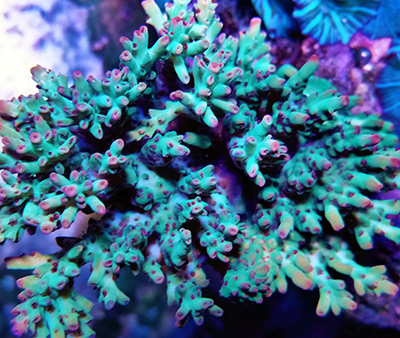Welcome to the next level of coral care. By now I am assuming you have at least understood all the key general practices to maintain some of the hardier corals, from soft corals to large-polyp stony (LPS) corals to some of the more rugged small-polyp stony (SPS) corals.
Each category of livestock can be classified into various requirements for the piece of ocean environment you are trying to simulate. Oftentimes we tend to generalize that all parts of the ocean are the same, but as you become educated about the livestock you are trying to maintain, you will understand that there is no single recipe to make everything thrive and flourish in the same tank.
Review time
So let us review some of the key attributes we, as responsible hobbyists and nature fans, must familiarize ourselves with in order to provide a sustainable environment.
The most common aquarium parameters are the following:
1. Tank dimensions
- Volume (amount of salt water for stability)
- Depth (impacts light penetration and available environmental zones)
- Size (impacts aquascaping, flow, lighting choices, growth)
2. Lighting
- Type: metal halide, T5, LED, or hybrids
- Spectrum (10,000 to 20,000 Kelvin)
- Intensity (lux)
- Photosynthetically Active Radiation (PAR)
- Photosynthetically Usable Radiation (PUR)
- Photoperiod (hours)
3. Flow
- Type: Laminar vs. turbulent
- Duration (pulse widths)
- Intensity (pulse amplitude)
4. Water parameters
- Salinity (SG/ppt)
- Temperature (C or F)
- Alkalinity (ppm/mEq/dKh)
- Calcium (ppm)
- Magnesium (ppm)
- Nitrates (ppm)
- Phosphates (ppm)
- Clarity (As clear as possibly to maintain proper light penetration. Granular activated carbon will aid in this activity.)
- Trace elements – Various elements impact specific colors, such as reds/pinks, blues, greens, and purples. Proper ratio of nitrates to phosphates will produce best colors and survivability of specific corals in various nutrient levels.
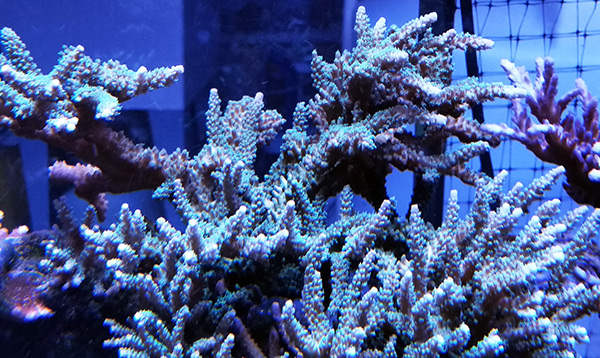
For this hobby, most especially for Acropora species of corals, water stability is essential. The level of variation for all parameters is held very tightly for the king of SPS corals. For years, those who had successfully grown out small frags to full colonies were looked upon with awe due to the longevity and maturity of the system. Mature, healthy, colorful colonies are the main reward.
In order to achieve such a system, one must meet all the Acropora requirements, which tend to include the following parameters. In my experience, I had to take tips from various systems like Red Sea Foundation and KZ Zeovit to produce an Ultra-Low-Nutrient System (ULNS)* similar to oceans where most of these corals are found.
Tank size
- The larger and shallower, the better, especially for beginners
Lighting
- Strong full-spectrum lighting (MH/T5/LED have all been successful)
Flow
- Strong and turbulent
Water parameters
- Salinity: 1.026 or 35 ppt
- Temperature: 78-80 F
- pH: 8.2-8.4
- Alkalinity: varies based on goal per Red Sea: color (8.2 dKh) vs. growth (12 dKh)
- Calcium: color (430 ppm), Growth (465 ppm)
- Magnesium: color (1310 ppm), Growth (1390 ppm)
- Nitrates: 2-5 ppm*
- Phosphates: 0.02-0.07 ppm*
- Clarity: As clear as possible to maintain proper light penetration. Granular activated carbon will aid in this activity.
- Trace elements and amino acids: Dose as needed, and it does improve colors in a high-bioload system.
*Note: A ULNS does not mean having 0 ppm nitrates and 0 ppm phosphates. Keeping these at 0 ppm will starve the zooxanthellae that reside in the corals. They are photosynthetic cells that act like little plants. Just as you add fertilizer to your garden, you need to provide nutrients for them to survive in addition to the correct lighting wavelength and clean water. This is underwater gardening to an extent.
Tank setup
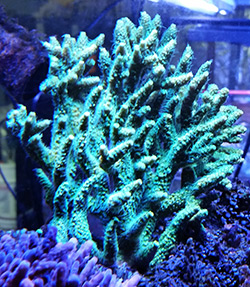
In addition to having a strong skimmer in the system, I have chosen to use solid carbon dosing with biopellets to reduce nitrates and phosphates. It has been one of the most efficient ways to produce a ULNS. The benefit of a biopellet reactor system is that the amount of bacteria adjusts itself automatically, controlling the bacterial population as the bioload changes. A refugium with macroalgae added to this also helps balance the uptake of phosphates, as carbon dosing works primarily on removing nitrates. You won’t have to worry about overdosing phosphate removers like granular ferrio marinec oxide (GFO), aluminum oxide, or lanthanum chloride (LaCL). Any spikes in water parameters can lead to rapid tissue necrosis (RTN), so any necessary changes should be made gradually over a few days.
If your system is super-efficient in removing nitrates and phosphates, you may find yourself needing to replenish by feeding more to keep the system within range. Overfeeding is one way to achieve this, but if just your nitrates are low, you may have to dose something like potassium nitrate (can be found as Spectracide Stump Remover*) to raise it back into range without impacting phosphates, which you want to remain low.
*Caution: You must be careful of dosing anything into the system. Accurate test kits are a must no matter what you are dosing. Specific recipes are available for many DIY solutions, such as Randy Holmes Farley’s DIY 2 Part for alkalinity (sodium bicarbonate—Arm and Hammer baking soda), calcium (100% pure calcium chloride—Ice Melt), and magnesium (magnesium sulfate—Epsom salt). For kalkwasser, use 100% pure calcium hydroxide or Mrs. Wages Pickling Lime.
Avoid sugar-fine sand, since Acropora will suffocate and die if they fall onto the sand and such a fine substrate material will make it difficult to provide the highly turbulent water flow that is necessary. Bare bottoms are best for frag tanks, but if you do decide on a substrate in a display tank, make sure the grains are larger.
Growth
If you are buying small coral frags, you will need to be more patient, since they take a lot longer to stabilize before any real growth is visible. Most Acropora follow these growth stages:
- Encrusting to get a firm base (why mounting the frags horizontally helps)
- Branching to expand surface area and mature
- Reproduction
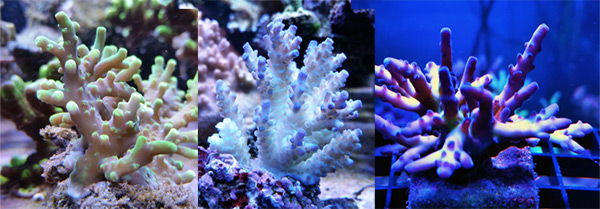
Hence, those who can access larger mini colonies will have a head start and won’t have to wait a few months before seeing any type of extended growth. As the colony grows and its surface area widens to gain more energy-producing flesh, the colony will take off.
One of the other tips related to stability outside of water parameters is to try to avoid moving the frags once they are settled in. Every time you move them, they may have to re-acclimate to the lighting and flow, delaying growth.
Be careful about the placement of your corals and be sure to understand their growth styles. Some are just encrusting, but many are either branching or tabling. Understanding their shapes will allow you to plan a more permanent position in the tank so your corals won’t conflict with each other or compete for lighting and water flow. Provide plenty of room around each coral or else they will start competing with each other. Learn the level of aggressiveness of each coral to avoid chemical and sweeper warfare.
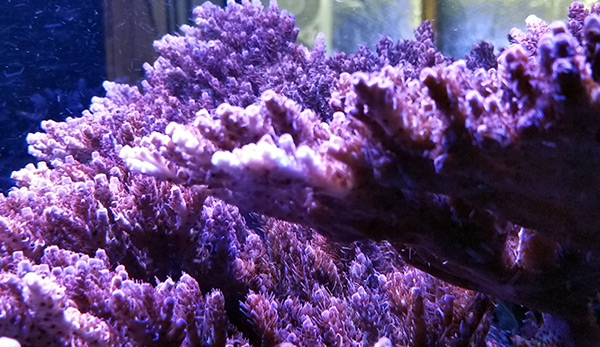
In an Acropora-dominated system, there are some key tankmates I have always included. Here’s a shortlist of what and why:
- Small sixline wrasse—Does not need sand and is great for controlling pest red bugs, flatworms, and bristleworms.
- Small rabbitfish—Depending on the tank size, they are great algae grazers and provide nutrients to the corals.
- Coral banded shrimp—Controls bristleworms and other parasites.
- Peppermint shrimps—Aiptasia control.
- Dragonface pipefish—Red bug and pod control.
- Trochus snails and blue-leg hermits—Algae control.
- Tridacna derasa—Hardiest of the clams and a great nitrate consumer.


